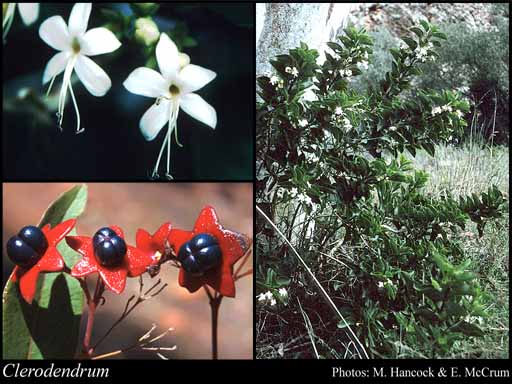- Reference
- Sp.Pl. [Linnaeus] 2:637 (1753)
- Name Status
- Current

Scientific Description
Family Verbenaceae.
Habit and leaf form. Small trees, or shrubs, or lianas; evergreen; bearing essential oils. Plants unarmed. Leaves cauline. Young stems cylindrical, or tetragonal (obtusely). To 1–8 m high. Self supporting, or climbing; the climbers stem twiners, or scrambling. Twining clockwise. Leaves medium-sized; not fasciculate; opposite; decussate; leathery, or membranous; not imbricate; petiolate; foetid, or without marked odour; simple; epulvinate. Leaf blades entire; flat; narrowly to broadly ovate, or elliptic (narrowly); pinnately veined; cross-venulate. Mature leaf blades adaxially glabrous (almost glabrescent), or pubescent to woolly (velvety); abaxially pubescent to woolly. Leaves without stipules. Leaf blade margins entire, or dentate (variously); flat. Leaves without a persistent basal meristem. Leaf anatomy. Hairs present; glandular hairs absent. Stem anatomy. Secondary thickening developing from a conventional cambial ring.
Reproductive type, pollination. Fertile flowers hermaphrodite. Unisexual flowers absent. Plants hermaphrodite. Entomophilous.
Inflorescence and flower features. Flowers aggregated in ‘inflorescences’. Inflorescence many-flowered. Flowers in cymes, or in heads, or in corymbs, or in panicles. The terminal inflorescence unit cymose. Inflorescences terminal, or axillary (rarely); cymes mostly loose-flowered or capitate, pedunculate, usually forming terminal or rarely axillary, corymbose or thyrsoid panicles; not pseudanthial. Flowers pedicellate, or subsessile; bracteate; bracteolate. Bracteoles not adnate to the receptacle. Flowers medium-sized to large (showy); very irregular; zygomorphic. The floral asymmetry involving the androecium, or involving the perianth and involving the androecium. Flowers 4–5 merous; cyclic; tetracyclic. Free hypanthium absent. Hypogynous disk present, or absent; annular. Perianth with distinct calyx and corolla; 10; 2 -whorled; isomerous. Calyx present; 5; 1 -whorled; gamosepalous; lobed; lobulate, or blunt-lobed, or toothed. Calyx lobes markedly shorter than the tube to markedly longer than the tube. Calyx spreading; exceeded by the corolla; somewhat campanulate, or tubular; regular; non-fleshy; persistent; accrescent; with the median member posterior. Calyx lobes narrowly to broadly ovate. Corolla present; 5; 1 -whorled; gamopetalous; lobed; blunt-lobed. Corolla lobes markedly shorter than the tube. Corolla imbricate; hypocrateriform and tubular; regular to unequal but not bilabiate; hairy abaxially, or glabrous abaxially; glabrous adaxially; plain; white. Corolla lobes ovate, or elliptic, or oblong, or rhombic. Corolla members entire. Androecium present. Androecial members definite in number. Androecium 4. Androecial sequence not determinable. Androecial members adnate (to the corolla tube); markedly unequal; free of one another; 1 -whorled. Androecium exclusively of fertile stamens. Stamens 4. Staminal insertion midway down the corolla tube, or in the throat of the corolla tube. Stamens inserted at markedly different levels, or all inserted at the same level; becoming exserted; didynamous; all more or less similar in shape; reduced in number relative to the adjacent perianth; fertile stamens representing the posterior-lateral pair and the anterior-lateral pair; oppositisepalous. Filaments glabrous; filiform. Anthers connivent, or separate from one another; dorsifixed; dehiscing via longitudinal slits; introrse; tetrasporangiate. Gynoecium 2 carpelled. The pistil 4 celled. Carpels reduced in number relative to the perianth. Gynoecium syncarpous; eu-syncarpous; superior. Ovary plurilocular; 2 locular. Locules secondarily divided by ‘false septa’. Gynoecium median. Ovary sessile. Ovary summit glabrous. Gynoecium stylate. Styles 1; simple; from a depression at the top of the ovary; apical; much longer than the ovary at anthesis; becoming exserted; hairless. Stigmas 1; 2 - lobed. Placentation axile. Ovules 2 per locule, or 1 per locule (per cell); pendulous, or horizontal, or ascending; non-arillate; hemianatropous.
Fruit and seed features. Fruit 5–24 mm long; fleshy; indehiscent; a drupe. The drupes with separable pyrenes. Fruit 4 celled. Dispersal unit the fruit. Seeds non-endospermic. Cotyledons 2 (expanded, flat). Embryo straight.
Special features. Calyx limb 5 lobed. Corolla tube exceeding the calyx; more or less straight.
Geography, cytology, number of species. Native of Australia. Endemic to Australia, or not endemic to Australia. Australian states and territories: Western Australia, Northern Territory, Queensland, and New South Wales. Northern Botanical Province. A genus of 584 species; 3 species in Western Australia; 0 endemic to Western Australia.
Etymology. From the Greek for "a lot, a drawing of lots" and "tree"; said to be named for its uncertain medicinal properties. Also spelt Clerodendron, but the spelling given is that of Linnaeus.